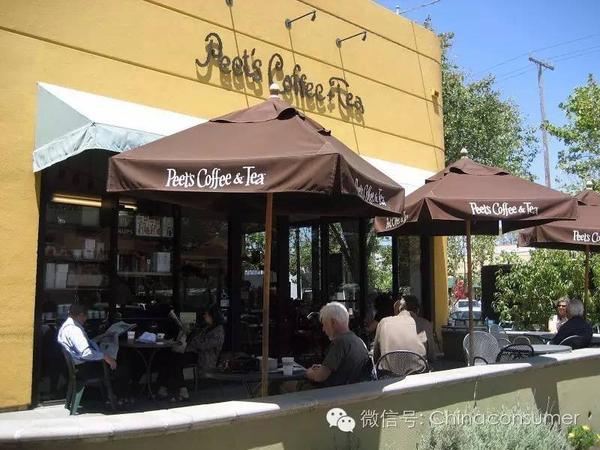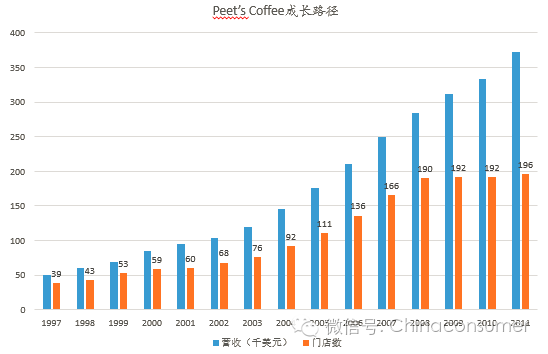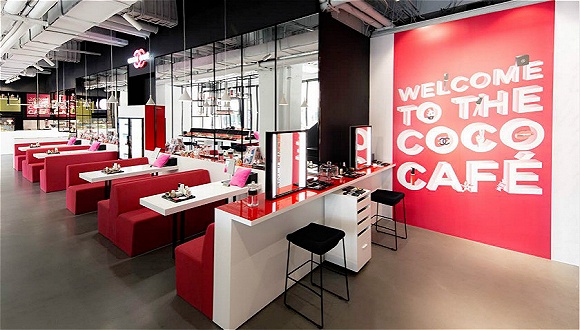Apocalypse-the Secret Coffee Empire-Jab Holdings
"Today's consumers no longer care whether a cup of coffee is cheap but whether it is of good quality or whether it is convenient or not."
The layout of Green Mountain Coffee and JDE in capsule Coffee introduced in the last issue is the representative of convenience while excellent quality is an important market for boutique coffee stores. Chain stores for Jab its strategic significance 1, bet on a single cup brewed high-quality coffee track 2, expand the sales channels of commercial coffee. We see that under the second section of the picture above, Jab not only acquires coffee chain stores, but also some donut chain stores and light meal chain stores that do not seem to have anything to do with coffee, in order to further expand the sales channels of coffee capsules, coffee beans and coffee powder.
This issue mainly introduces Peet's coffee, the core of Jab chain boutique coffee.
Peet's coffee
The story between Peet's Coffee- and Starbucks
Peet's coffee was founded five years earlier than Starbucks in 1966 and was one of the first cafes to introduce deep-roasted Arabica beans. The main business model is to sell coffee drinks as well as roasted coffee beans. This was also the main mode of operation of cafes in the United States at that time.
What is more legendary is that the original three Starbucks founders-Gordon Pocker, Jeff Seeger and Jerry Baldwin-were all influenced by Peet's coffee. The coffee beans in the first year of Starbucks were bought from Peet's.
In 1984 Alfred Peet, the founder of Peet's Coffee, decided to sell Peet's. Gordon Pocker, one of the founding fathers of Starbucks, took over and bought it. Starbucks and Peet's are actually the same store for a while. After buying Peet's, executives are flying around trying to manage Starbucks in Seattle and Peet's in San Francisco at the same time. In the end, Gerald Baldwin and Gordon Pocker abandoned the Starbucks they founded and sold it to Holder Schultz, then one of the executives. But what they didn't expect at the time was that the future Starbucks would become a company with a market capitalization of nearly $80 billion.

The Development path of Peet's coffee
In January 2001, the total annual revenue of 60 stores in IPO was US $84.3 million. It took 20 years to open the first 100 stores from the time it was spun off from Starbucks in 1984. It took seven years to open the second 100 stores. After 2008, its revenue continued to climb without much increase in the number of stores. The main growth comes from the Specialtv business selling tea, tea bags, jams and snacks through chain retailers such as Safeway, Stop&shop, Kroger and whole foods. This revenue rose from $97.1 million in 2008 to $157 million in 2012. Revenue from its store business was $187 million in 2008 and $214 million in 2012.

Peet's coffee was privatized by Jab in 2012, when Peets' had annual revenues of $372 million and in 2011 there were 196 stores. After the acquisition, Jab adjusted its overall business and store opening strategy to pull the business center back to increase store revenue. In 2014, Peet's 's overall revenue reached $540 million.
So far, the total number of stores in the main Peet's coffee is 245, of which 189 are mainly in California. Peet's alone may not quite understand Jab's intentions, but looking at the history of Starbucks since 1971, we can find some interesting findings.
Starbucks opened its first store in Seattle in 1971 but mainly focused on selling coffee beans. Starbucks sold coffee drinks immediately after Schultz returned home in 1983 when he saw that Milan was full of cafes. The number of Starbucks stores was 17 in 1987, 33 in 1988 and 55 in 1989, 84 in 1990 and 165 in 1991. It can be seen that it took 20 years for Starbucks to develop its first 100 stores before IPO in 1992. After reaching 272 stores in 1993, the annual number of new stores is more than 200 and after 600 stores, the annual number of new stores is more than 400.
Put Starbucks' path and Peet's coffee together to see Jab choose Peet's coffee for several reasons Peet's already has a certain store size but the original deep-roasted coffee chain can no longer compete with Starbucks. However, based on the stock of its stores and years of brand accumulation, there is a lot of room for adjustment and imagination. Secondly, from the path of Starbucks, Peet's is in the early stage of the next stage of rapid growth. Peet's coffee, which has already broken through 200 stores when it was acquired by Jab, is very hopeful to break through the bottleneck of 300 stores under the support of capital intervention and external operation ability to enter the next period of high-speed growth.
Peet's 's road to boutique coffee

Peet's was originally positioned to be of higher quality than Starbucks products, supplemented by deep-roasted boutique coffee. In the chain coffee field characterized by deep roasting, the competition pattern has been stereotyped. It is difficult to achieve further epitaxial growth. Jab intends to comply with the trend of the third generation of coffee and use Peet's coffee as a carrier to build a new generation of coffee chain brand dominated by boutique coffee. In 2015, there were two major events in the coffee industry. Peet's successively acquired three representative brands of the third wave of coffee, and two of the pictures below are "Stumptown" and "Intelligentsia Coffee". At present, the two brands are still operating independently after the acquisition.
In October 2015, Peet's acquired Stumptown, a boutique coffee known for its bottled cold drops, and sold it as an independent brand through its cafes, wholesale and retail channels.
Stumptown opened its first New York store in Manhattan in 2009. In 2010, a new coffee shop offering only follicles was opened in New York. Unlike in the past, consumers of milk coffee made from espresso drink coffee made by hand tools such as French kettle, hand filter pot, Philharmonic pressure and so on.
In November of the same year, Peet's announced that it would acquire a majority stake in Chicago roaster Intelligentsia Coffee, and Intelligentsia would continue to operate independently.
Intelligentsia Coffee was founded in 1995 and 2015 with a total of 10 stores and 2 coffee roasters in Chicago, Los Angeles and New York. There are 4 baristas in Intelligentsia Coffee since 2003. "baristas have won the championship of the American barista contest USBC, which is why it is called Harvard in the coffee world." "Intelligentsia" has its own coffee training mechanism involving production technology, raw bean roasting, production control and coffee trade, and it is the control of these links that directly ensures its quality.
Caribou, the second coffee chain brand bought by JAB
Caribou is the second largest coffee chain in the United States, which went public in 2005. It was privatized by JAB in 2012 at a price of $340 million. In 2012, Caribou had 610 stores with annual revenue of 330 million. Among them, coffee stores accounted for 74.3% of revenue, commercial coffee business accounted for 25.7%. Mainly through grocery stores, stores and other channels to sell coffee beans and single-cup coffee machine capsules.
In 2014, 80 Chicago-based Caribou closed stores and opened new Peet's stores on the same site because of poor business conditions. On the staff side, the original staff of Caribou will be retrained for several weeks from a "machine operator" who presses a few buttons to become a certified barista of Peet's. Some of the same Caribous stores in Ohio, Michigan, Pennsylvania and Washington, D.C., have been converted into Peet's stores. The total number of Caribou stores fell to 468. Reduce the range of stores from 22 states to 11 states concentrated in mid-western cities.
Judging from the breakdown of revenue before being privatized, same-store growth has been negative since 2006-2010. The main reason for the same-store growth since 2011 is not the further growth of its store coffee business, but the addition of breakfast sandwiches to drive sales growth.
Sales of Caribou commercialized coffee maintained a compound growth rate of 53 per cent between 2005 and 2011. The commercial coffee business accounted for 25.7% of Caribou's revenue in 2012. In this way, it seems that the logic of Jab's shop closure is more acceptable.
Important Notice :
前街咖啡 FrontStreet Coffee has moved to new addredd:
FrontStreet Coffee Address: 315,Donghua East Road,GuangZhou
Tel:020 38364473
- Prev

Chanel finally opened a time-limited coffee shop in Shanghai, but the real deal was lip lotion and nail polish.
Coco Caf Interior at the intersection of Nanjing West Road and Huashan Road in Jing 'an District, Shanghai City Source: Chanel In addition to inviting stars to advertise and promote, how can makeup be sold? Especially in this age of social media, how can offline channels and online user sharing form a complementary cycle? Chanel's play this time is in downtown Jing 'an, Shanghai
- Next

The coffee shop is like an old friend, full of the flavor of the scene.
Let the story happen, is the best gift I can give you. Knowing this cafe begins with the sentence of NANA, the owner and director of the cafe. The first two words were a little difficult, and I looked them up in the dictionary, ji Jia and bi. In Japanese, coffee means Jia Jia in the Chinese character list. I prefer other things to Jia times.
Related
- What documents do you need to go through to open a coffee shop? coffee shop coffee shop certificate processing process
- How to purchase Coffee beans in small Cafe how to choose a suitable supplier for domestic Coffee supply Company
- How to drink Starbucks Fragrance White Coffee? how to make Australian White Coffee? what Italian coffee beans are recommended?
- The Story of Flora Coffee: the name of Flora Coffee Bean and the implication of the Flowers on Florna Coffee
- How much does a cup of coffee cost? How much is the profit of a cup of coffee? What is the profit of the coffee shop in a year?
- Yunnan small Coffee, known as "fragrant Coffee", introduces the characteristics of Alpine Arabica Coffee producing areas in Yunnan, China
- 2023 latest Starbucks full menu price list how much is a cup of Starbucks coffee what is better to drink the most popular hot and cold drinks recommended
- Starbucks different kinds of Coffee Price list Starbucks menu 2023 Top Ten Best drinks in Starbucks
- Starbucks Spring praise Comprehensive matching Coffee Bean theme Story Packaging implication and taste description
- The cost of a cup of coffee latte American coffee cost price and selling price

